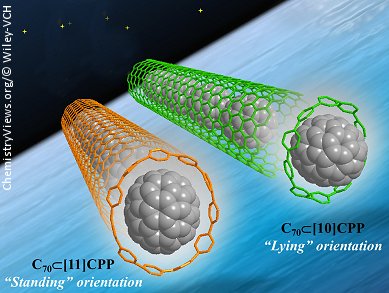Fullerene peapods are a new class of structurally ordered carbon networks. They are formed by the encapsulation of fullerenes by single-walled carbon nanotubes without the involvement of covalent bonds.
Shigeru Yamago, Kyoto University, Japan, in collaboration with groups at Hiroshima University, Japan, and the Japan Synchrotron Radiation Research Institute have managed to selectively prepare two C70 peapods, in which the C70 moiety is encapsulated in either [10]- or [11]cycloparaphenylene (CPP), that is, short carbon nanotubes.
C70 exists in two distinct orientations inside the CPP cavity, namely “lying” and “standing”, depending on the size of the CPP. The researchers found that the key factor for controlling of orientation of the fullerene guest was the ability of the nanotube to behave in an elastic fashion. This leads to induced-fit π–π interactions between the host and the guest.
These findings have added to the understanding of the concave–convex π–π interactions and will be useful for the future design and development of new hierarchically and dimensionally ordered π-layered complexes based on a bottom-up strategy, the team says.
- Size- and Orientation-Selective Encapsulation of C70 by Cycloparaphenylenes,
T. Iwamoto, Y. Watanabe, H. Takaya, T. Haino, N. Yasuda, S. Yamago,
Chem. Eur. J. 2013.
DOI: 10.1002/chem.201302694



